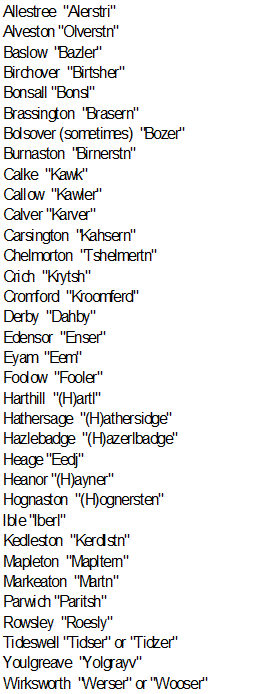
| home
Peak District Place Names
Origins:
Language
|
Typical element
|
Example:
|
Norman French
|
Beauchief
|
|
Norse
|
...beck ...thorpe ...gate....grain
|
Holbeck
Millthorpe
Dane
Deep Grain
Saltergate
Grimbocar
Odin (mine)
|
Anglo Saxon
|
...feld ...leah ...ing ...inga ..hlaw ...low
|
Padley, Barnsley
Whittington, Minninglow
Wensley
|
Latin
|
...castra ...ceaster
|
Chester (field)
|
Celtic
|
eccles..
|
Eccles Pike
Ecclesfield
Eccleshall
|
Pre Celtic ???
|
Kinder
|
Anglo Saxon Place Names
Meaning & Example
|
|
..ing
|
The village of the followers of a leader: Tissington = Tid's peoples village
|
..tun / ...ton
|
A village or farm: Middleton = middle farm
|
...stoke
|
An outlying farm: Stoke Flat (above Padley)
|
...well
|
A stream or spring if used in an ending : Bakewell
|
...ford
|
A river crossing: Bamford = a ford with a footbridge
|
...ley
|
A clearing : Rowsley
|
nb - for a detailed analysis see: "Peak Place-Names" L.McMeeken, Halsgrove 2003
Pronunciation:
Derbyshire dialect means that many names, shown below in quotes, sound quite unlike their spellings:

This is a Web Counter
This page has been accessed